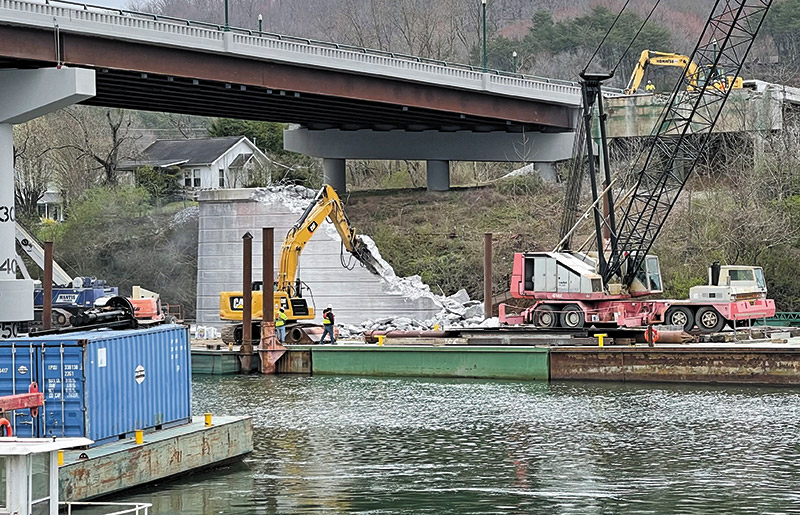Green Bridge’s piers are being chipped away, debris will be removed

Barges sit on the Clinch River near the new bridge in South Clinton as workers take down one of the piers of the old Green Bridge. (photo:G. Chambers Williams III )
Crews working from barges in the river were chipping away at the first of the two piers last Friday, using a machine with a hydraulic jackhammer to crumble the pier, whose remains will be gathered up and carried out by barge.
Lynn Murphy, the former Clinton public works director who is now the city’s liaison with the state Department of Transportation and the new bridge contractor, summed up the pier-removal process this way on Friday:
“There has been a change in plans for the removal of the two concrete bridge piers that remain in the river,” he said. “Rather than using a barge-mounted horizontal concrete saw as originally planned, crews will use a large excavator (track-hoe) equipped with a hydraulic jackhammer.
“Once the concrete piers are taken down to within a few feet above the water surface level, vertical drilling and underwater blasting will take place,” he said.
There will be no pollution resulting from the pier removal, and no debris will be left under water, as that area of the Clinch River is navigable by barge, and is required to remain clear of hazards, officials have said.
“No concrete wastes or debris will be allowed to remain in the river,” Murphy said. “Empty barges will be positioned on each side of [the] piers to collect concrete debris while hammering/demolition takes place.
“Concrete debris created by the underwater blasting will be removed using a crane equipped with a clamshell bucket,” Murphy sid. “Divers will be used to verify that all debris is removed.”
It’s been a long process, but the entire project, beginning with construction of the new Lewallen Bridge and removal of the old bridge, will be finished when the final pieces of the Green Bridge’s supports are removed and Riverside Drive underneath the bridge is rebuilt and reopened to the public.
It has been an annoyance to drivers in the area for more than three years, but the last big disruptive project was the grooving of the traffic lanes on the new bridge, which was completed on Jan. 15.
Grooving of the concrete deck was “designed to channel stormwater off of the road surface (similar to tire treads), and to provide a higher-friction contact surface,” Murphy said earlier.
The only possible traffic disruptions left may come when crews complete the permanent lane marking and striping work this spring.
As for the permanent lane striping, the state’s engineers are working on a solution to make the lanes easy for motorists to negotiate, Murphy said.
“TDOT is now exploring options for pavement markings on the bridge, as well as lane markings at the State Route 9 (Clinch Avenue) and State Route 61 (Charles G. Seivers Boulevard) intersections,” Murphy said earlier.
The state opened part of the new bridge to traffic last Oct. 12, but some of the lanes on the south side of the span remained closed as workers finished building bike lanes, sidewalks and the center dividing lane.
The remaining lanes were opened to traffic in mid-December.
Work on the new bridge began in September 2018. Contractor for the $27.6 million dollar project is Charles Blalock and Sons, Inc. of Sevierville.

